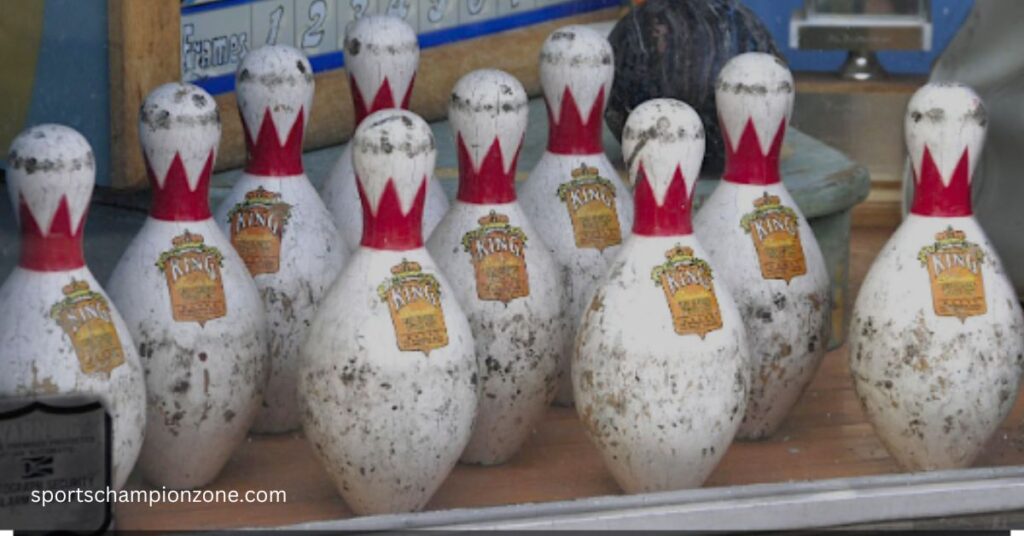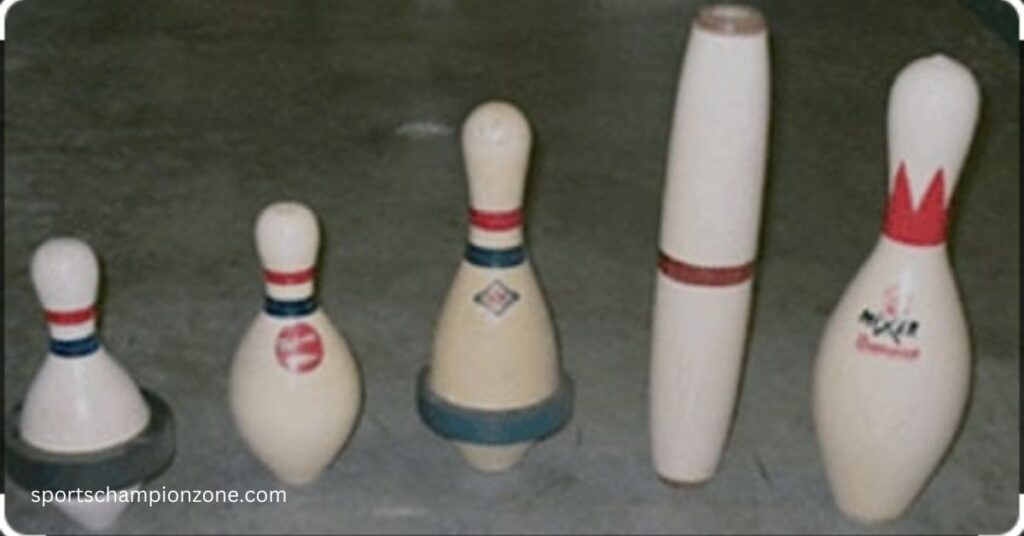“Duckpin bowling rules are easy! In this fun game, players roll small, squat pins with a ball that fits in the palm. “Duckpin bowling rules: Roll small balls to knock down short pins. Three rolls per frame. Clearing all pins in two scores a strike.” Aim for strikes and spares like in regular bowling, but here, you get three rolls per frame. Knocking down all pins in two rolls still counts as a strike! Plus, there’s no need to fuss with heavy balls or big pins. It’s a great twist on traditional bowling, perfect for families and friends looking for a relaxed yet challenging game night.”
Duckpin Bowling rules resembles conventional bowling’s delightful cousin, including more limited, vagrant pins and more modest, lighter balls. It’s a round of accuracy and artfulness, where each roll counts and strikes are praised like triumphs. Duckpin bowling rules balls are somewhat small forces to be reckoned with, fitting cozily in the center of your hand. Not at all like their bigger cousins in ten-pin bowling, these balls ordinarily weigh somewhere in the range of 2 and 3.5 pounds (around 0.9 to 1.6 kilograms). They’re simpler to deal with, making them ideal for bowlers of any age and ability levels.

The Charming Duckpin Bowling Pins
The superstars, duckpin bowling pins, stand happily at simply 9.4 inches (around 24 centimeters) tall. That is generally around 50% of the level of their ten-pin partners, yet don’t allow their height to trick you. They’re brimming with character and flexibility.
Understanding Duckpin Bowling Lanes
Duckpin Bowling Lane Layout
Duckpin bowling rules lanes are like jungle gyms for bowlers, with every path offering a make way to triumph. We should go for a walk down the path and investigate its design. Toward the start of the path, you’ll track down the methodology region. This is where bowlers stand to give their efforts.
It resembles the runway for your bowling ball a smooth surface drives directly to the pins. Dropping farther down the lane, you’ll go over the pin deck. This is where the activity occurs, where pins stand tall and anticipate their destiny. It’s the final location for each roll, where strikes are conceived and saves prevail.
Foul Lines: Where Rules Keep You in Line
Presently, we should discuss foul lines. These resemble undetectable hindrances that keep the game good all around. Foul lines are situated toward the start of the methodology region, not long before the pin deck.
They’re typically set apart with a slender line or a progression of spots. While you’re bowling, keeping your feet behind these lines during your methodology and release is pivotal. Getting over the foul line brings about a foul, which can influence your score and even invalidate an ideal shot.
Understanding Duckpin Bowling Scoring
Scorings in duckpin bowling rules could appear to be a bit precarious from the start. However, sit back and relax, it’s basically as simple as thumping down pins.
Scoring Basics
In duckpin bowling rules, each edge comprises up to three rolls, contingent upon the number of pins you wreck. You want to score whatever number focuses as could reasonably be expected by thumping down pins with each roll.
Strikes: The Ultimate Victory
A strike happens when you thump down every one of the ten pins with your most memorable roll on an edge. It resembles hitting a grand slam in baseball, an ideal shot that procures you large focuses. Whenever you score a strike, you get 10 focus points, in addition to the complete number of pins you wreck with your next two rolls. Strikes are amazing chances to pile up enormous focus and flaunt your bowling ability.

Open Frames: Room for Improvement
On the off chance that you don’t thump down each of the ten pins with your three rolls in a casing, it’s called an open edge. It resembles getting a fair hit in baseball, not a grand slam, yet at the same time an opportunity to score focuses. In an open edge, you procure one point for each pin you wreck. Open casings advise you that there’s consistently opportunity to get better and propel you to go for the gold and extras.
Understanding Pin Count Carryover
Pin count vestige could sound over whelming, but it’s very basic once you get its hang. We should separate it into straightforward advances.
Pin Count Fundamentals
In duckpin bowling rules, you want to wreck as many pins as could be expected under the circumstances with each roll. In any case, what befalls the pins you don’t wreck? That is where the pin count remainder becomes an integral factor.
Carrying Over Pins Between Frames
Envision you thumping down seven pins with your most memorable roll in the primary casing. Those three excess pins? They don’t vanish immediately and inexplicably. All things being equal, their count persists until your next roll with a similar edge. So assuming that you thump down two additional pins with your subsequent roll, you’ve scored a sum of nine pins for that edge.
Pin Count Carryover
Suppose you thump down six pins with your most memorable roll in the subsequent casing. Since you had an extra in the principal outline, those six pins add to your extra’s reward roll. In the event that you thump down four additional pins with your second roll in the subsequent edge, you’ve scored a sum of ten pins for the subsequent casing, consolidating the vestige from the extra with the pins you wrecked there.
Player’s Turn Structure in Duckpin Bowling Rules
Overview of A Player’s Turn
In duckpin bowling rules , every player’s turn resembles a scaled down experience, comprising up to three rolls for each edge. We should separate the design of a player’s chance into basic advances.
First Roll: Setting the Stage
The player moves forward to the methodology region, with the ball close by, prepared to influence the path. With accuracy and concentration, they hold back nothing toward the end of the path and deliver the ball. This first roll makes way for the edge, deciding the number of pins the player will wreck and establishing the vibe for their next rolls.

Second Roll: Making Adjustments
In the event that the player doesn’t score a hit with their most memorable roll, they get an opportunity to make changes with their subsequent roll. Perhaps they’ll point slightly to one side or add a smidgen more twist to the ball. With cautious estimation, they discharge the ball once more, planning to wreck as many leftover pins as would be prudent. This subsequent roll is about calibrating their methodology and boosting their pin count for the edge.
Third Roll (if necessary): Making it happen
Assuming that the player actually has pins remaining after their subsequent roll, dread not; there’s as yet another opportunity to score. With their third roll, they go after those obstinate pins, meaning to finish the casing with an extra or possibly further develop their pin count. This third roll is their last open door to have an effect on the ongoing edge prior to continuing on to the following.
Pointing Between the Pins
In duckpin bowling rules, going for the gold between the pins is pivotal because of the more modest size of the ball. We should investigate why this procedure is so significant in straightforward terms.
Smaller Ball, Smaller Margin for Error
Duckpin bowling rules balls are more modest and lighter than conventional bowling balls, making them trickier to control with pinpoint precision. Along these bowling lanes, pointing straightforwardly at the pins can prompt unusual outcomes. All things considered, going for the gold between the pins offers a bigger objective region and a superior possibility of hitting your imprint.

By pointing between the pins, you increment your possibilities, thumping down additional pins with each roll. Regardless of whether your ball connects with a pin, it can, in any case, bounce away from neighboring pins and prompt them to tumble. This truly intends that by pointing decisively between the pins, you create a cascading type of influence that can prompt higher scores and more reliable exhibitions.
Reducing the Risk of Gutter
Balls Pointing between the pins likewise decreases the gamble of drain balls, where the ball rolls into the drain without contacting any pins. With the more modest size of duckpin bowling rules ball rules, it’s simpler for them to slip into the drains whenever pointed straightforwardly at the pins. By pointing between the pins, you allow your ball a superior opportunity of remaining on track and staying away from those feared drain balls.
Understanding Fouls in Duckpin Bowling
What are fouls?
Fouls in duckpin bowling rules happen when a player crosses the foul line during their turn. The foul line resembles a limit that denotes the constraint of where a player can remain while making their roll. Crossing this line brings about a foul, which can have ramifications for scoring and ongoing interaction.
How Fouls Affect Scoring
Fouls can influence scoring in more than one way. In the first place, on the off chance that a player carries out a foul yet figures out how to thump down pins with their roll, those pins may not combine with their score. This can bring about a lower score for the edge and influence the player’s general exhibition.
Impact on Gameplay
Fouls can likewise influence interactivity by disturbing a player’s mood and focus. Very much like in any game, keeping up with concentration and adhering to the guidelines are fundamental for the outcome of duckpin bowling rules . Committing fouls can break the progression of the game and lead to dissatisfaction for the player and their partners. Fouls might bring about punishments or preclusion from the game, contingent upon the principles of the duckpin bowling rules alley or competition.

Mastering the Duckpin Bowling Technique
Improving Ball Control and Footwork
Ball control and footwork are fundamental components of a duckpin bowling rules method.
- Steady Grip: Guarantee a firm however loosened up grasp. Excessively close, and you could completely let go; excessively free, and the ball could slip. Find an agreeable grasp that permits you to keep up with control all through your roll.
- Smooth Approach: Practice a smooth, reliable way to deal with the foul line. Keep your means small and controlled, keeping a consistent musicality as you stroll towards your objective.
- Focus on Timing: Coordinate your footwork with your arm swing to accomplish ideal timing. Your means and arm swing ought to cooperate as one, with your delivery happening at the right second for the most extreme exactness.
- Spare Shooting: Go for the gold between pins to expand your possibilities when changing over saves. Picture a line between the pins; you’re holding back nothing on hitting that objective with accuracy.
- Frame Management: the event that you’re ahead in the game, center around keeping up with your lead by reliably hitting your imprints. Assuming that you’re behind, focus on making key shots to close the hole and put a squeeze on your adversaries.
Mental Focus: The Key to Consistency
Keeping up with the mental center is critical for consistency and progress in duckpin bowling rules. Here are a few hints to assist you with remaining intellectually sharp on these lanes:
- Visualization: Before each roll, picture yourself hitting your objective and thumping down the pins. Positive representation can assist with certainty and further develop execution.
- Stay Calm Under Pressure: Take full breaths and keep even-tempered, particularly in high-pressure circumstances. Try not to let errors or difficulties shake your certainty; stay fixed on the job that needs to be done and keep an uplifting outlook.
- Focus on the Present: Abstain from harping on past rolls or agonizing over future casings. Remain at the moment and focus on making the most ideal shot with each roll.
What is a Duckpin Bowling Ball?
A duckpin bowling ball is around 4 to 5 downers in distance and weighs around 3.5 to 4 pounds. Not by any stretch like tenpin balls, duckpin balls don’t have finger openings, making them significantly more obvious to hold with the entire hand. They’re normal for players of any age and strength levels, offering an unreasonableness and testing bowling experience. Considering their size and weight, duckpin balls are all the more obvious to make due, making them legitimate for teens and young people.
Why is it called Duckpin?
“Duckpin” bowling gets its name from the condition of the pins used in the game, which are more restricted and transient, appearing differently in relation to standard bowling pins. They seem to be the condition of a duck, subsequently known as “duckpin.” The more unobtrusive size of the pins makes them harder to wreck, adding an extra test to the game. Duckpin bowling began in the US in the late nineteenth century and has since gained predominance in unambiguous areas, particularly in the northeastern part of the country. It offers a silly and extraordinary bowling experience for players of all skill levels.
How many balls are in a duckpin?
In duckpin bowling, players typically roll three balls for each edge, not by any stretch like the standard ten-pin bowling where they roll two balls for each packaging. Each player gets up to three potential chances to pound down all of the ten pins in each packaging. This extra ball per frame adds an additional layer of philosophy and challenge to the game, as players have more opportunities to score centers or more problematic pin plans. By and large, the three-ball association of duckpin bowling gives an intriguing and lovely experience for bowlers of all ages and mastery levels.
Do duckpin balls have holes?
Yes, duckpin balls genuinely have openings, especially like customary bowling balls. These finger openings license players to get a handle on the ball effectively and securely while dropping it down the road. In any case, bowling ball are in size and stand out from ten-pin bowling balls, and their finger openings are correspondingly more unassuming. Besides, duckpin balls usually have a round and empty shape rather than the round condition of ten-pin bowling balls.
Conclusion:
In conclusion; duckpin bowling rules requires a blend of procedure, methodology, and mental concentration. By rehearsing ball control and footwork, holding back nothing shots, and overseeing outlines, you can work on your game and increment your odds of coming out on top. Make sure to remain mentally collected under tension, picture achievement, and spotlight each roll as it comes. With commitment and diligence, you can turn into a talented and certain bowler. So continue to rehearse, remain positive, and partake in the excursion of dominating this tomfoolery and remunerating sport.
If you wan to more detail and better information about this you can also visit:
